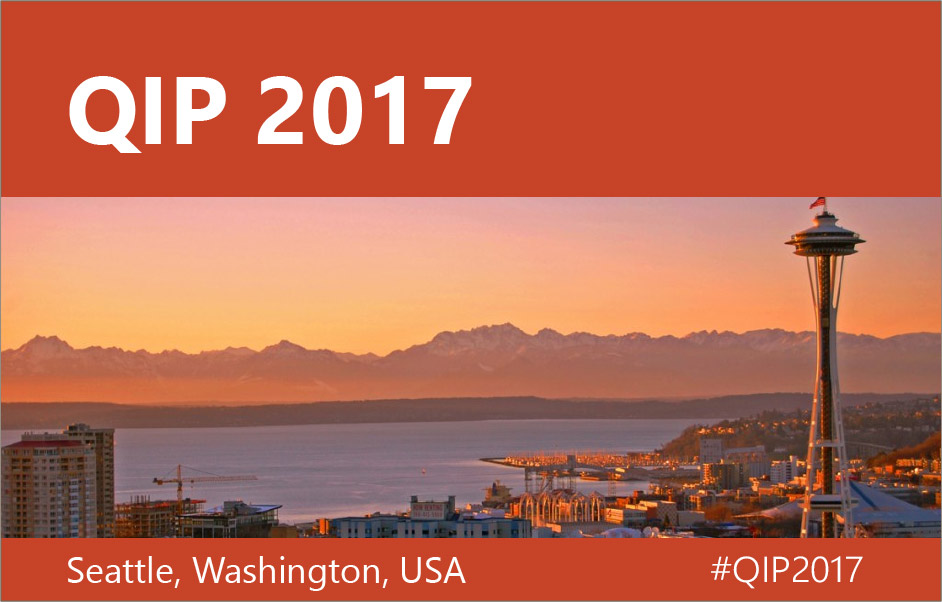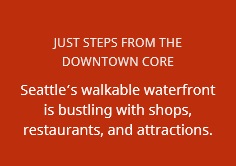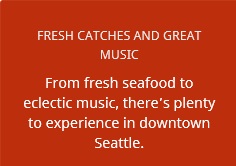Saturday, January 14, 2017
Morning tutorial
Debugging the next generation of quantum devices
Steve Flammia
Presentation slides | Videos: Tutorial 1, Tutorial 2
Afternoon tutorial
Quantum thermodynamics
Lídia del Rio
Presentation slides | Videos: Tutorial 1, Tutorial 2
Sunday, January 15, 2017
Morning tutorial
Matrix product states and tensor networks
Norbert Schuch
Presentation slides | Videos: Tutorial 1, Tutorial 2
Afternoon tutorial
Quantum information and spacetime
John Preskill
Presentation slides | Videos: Tutorial 1, Tutorial 2
Monday, January 16, 2017
8:00-8:45
Registration
8:45-9:00
Welcoming address
9:00-10:00
Plenary talk I: Chair: Fang Song (Grand Ballroom I + II)
Quantum homomorphic encryption for polynomial-sized circuits (Best Student Paper)
Yfke Dulek, Christian Schaffner, and Florian Speelman
Presentation slides | Abstract and video
10:00-10:30
Coffee break
10:30-12:30
Parallel session I-A: Chair: André Chailloux (Grand Ballroom I)
10:30-11:10
Zero-knowledge proof systems for QMA
Anne Broadbent, Zhengfeng Ji, Fang Song, and John Watrous
Presentation slides | Abstract and video
11:10-11:50
Compression of quantum multi-prover interactive proofs
Zhengfeng Ji
Presentation slides | Abstract and video
11:50-12:30
Sequential measurements, disturbance and property testing
Aram Harrow, Cedric Lin, and Ashley Montanaro
Presentation slides | Abstract and video
Parallel session I-B: Chair: David Poulin (Grand Ballroom II)
10:30-11:10
Unifying gate-synthesis and magic state distillation
Earl Campbell and Mark Howard
Presentation slides | Abstract and video
11:10-11:50
Application of a resource theory for magic states to fault-tolerant quantum computing
Mark Howard and Earl Campbell
Presentation slides | Abstract and video
11:50-12:30
Time-correlated noise in quantum computation
Héctor Bombín
Presentation slides | Abstract and video
12:30-2:00
Lunch break
2:00-3:20
Parallel session II-A: Chair: Jérémie Roland (Grand Ballroom I)
2:00-2:40
Separations in communication complexity using cheat sheets and information complexity
Anurag Anshu, Aleksandrs Belovs, Shalev Ben-David, Mika Göös, Rahul Jain, Robin Kothari, Troy Lee, and Miklos Santha
Presentation slides | Abstract and video
2:40-3:20
Information-theoretic tools for interactive quantum protocols, and applications: flow of information, augmented index, and DYCK(2)
Mathieu Laurière, Ashwin Nayak, and Dave Touchette
Presentation slides | Abstract and video
Parallel session II-B: Chair: Karol Horodecki (Grand Ballroom II
2:00-2:40
Energy as a detector of nonlocality of many-body spin systems
Jordi Tura Brugués, Gemma de Las Cuevas, Remigiusz Augusiak, Maciej Lewenstein, Antonio Acín, and Ignacio Cirac
Presentation slides | Abstract and video
2:40-3:20
A resource theory for work and heat
Carlo Sparaciari, Jonathan Oppenheim, and Tobias Fritz
Presentation slides | Abstract and video
3:20-3:50
Coffee break + mentor sessions
Sign up for mentoring using available sheets.
3:50-4:50
Plenary talk II: Chair: Andrew Doherty (Grand Ballroom I + II)
The entanglement of distillation for gauge theories
Karel Van Acoleyen, Volkher Scholz, Michael Marien, Nick Bultinck, Jutho Haegemen, and Frank Verstraete
Abstract and video
4:50-6:30
Poster session I: (Grand Ballroom III)
Hors d’Oeuvres and drinks will be provided. Vote for best poster using the tickets in your badge.
8:00-9:30
Software demo I: Will Zeng: Rigetti Computing (Grand Ballroom I + II)
Video
Tuesday, January 17, 2017
9:00-10:00
Invited talk I: Chair: Peter Shor (Grand Ballroom I + II)
Simulating quantum systems on classical computers
Garnet Chan
Presentation slides | Abstract and video
10:00-10:30
Coffee break
10:30-12:30
Parallel session III-A: Chair: Aram Harrow (Grand Ballroom I)
10:30-11:10
Quantum speed-ups for semidefinite programming
Fernando Brandao and Krysta Svore
Presentation slides | Abstract and video
11:10-11:50
Quantum recommendation systems
Iordanis Kerenidis and Anupam Prakash
Presentation slides | Abstract and video
11:50-12:30
A complete characterization of unitary quantum space
Bill Fefferman and Cedric Yen-Yu Lin
Presentation slides | Abstract and video
Parallel session III-B: Chair: Todd Brun (Grand Ballroom II)
10:30-11:10
Belief propagation decoding of quantum channels by passing quantum messages
Joseph M. Renes
Presentation slides | Abstract and video
11:10-11:50
Biunitary constructions in quantum information
David Reutter and Jamie Vicary
Presentation slides | Abstract and video
11:50-12:30
Catalytic Decoupling
Christian Majenz, Mario Berta, Frédéric Dupuis, Renato Renner, and Matthias Christandl,
merged with:
Deconstruction and conditional erasure of quantum correlations
Mario Berta, Fernando Brandao, Christian Majenz, and Mark Wilde
Presentation slides | Abstract and video
12:30-2:00
Lunch break
2:00-3:20
Parallel session IV-A: (Grand Ballroom I, Chair: Xiaodi Wu)
2:00-2:40
Asymptotic entanglement manipulation under PPT operations: new SDP bounds and irreversibility
Xin Wang and Runyao Duan
Presentation slides | Abstract and video
2:40-3:20
Operator scaling and applications
Ankit Garg, Leonid Gurvits, Rafael Oliveira, and Avi Wigderson
Presentation slides | Abstract and video
Parallel session IV-B: (Grand Ballroom II, Chair: Miklos Santha)
2:00-2:40
Optimal quantum sample complexity of learning algorithms
Srinivasan Arunachalam and Ronald de Wolf
Presentation slides | Abstract and video
2:40-3:20
Efficient quantum walk on the grid with multiple marked elements
Peter Høyer and Mojtaba Komeili
merged with:
Controlled quantum amplification
Cătălin Dohotaru and Peter Høyer
Presentation slides | Abstract and video
3:20-3:50
Coffee break + mentor sessions (sign up for mentoring using available sheets)
3:50-4:50
Invited talk II: Chair: Jonathan Oppenheim (Grand Ballroom I + II)
Racing classical computers with quantum boson-sampling machines
Chaoyang Lu
Abstract and video
4:50-6:30
Poster session II: (Grand Ballroom III)
Hors d’Oeuvres and drinks will be provided. Vote for best poster using the tickets in your badge.
8:00-9:30
Software demo II: (Grand Ballroom I + II)
Dave Wecker: Microsoft LIQUi|>
Video
Wednesday, January 18, 2017
9:00-10:00
Plenary talk III: Chair: Fernando Brandao (Grand Ballroom I + II)
From quantum thermodynamical identities to a second law equality
Alvaro Alhambra, Jonathan Oppenheim, Chris Perry, and Lluis Masanes
Presentation slides | Abstract and video
10:00
Group photo
Follow the crowd! We’d love to have you in that picture!
10:00-10:20
Coffee break
10:20-11:40
Parallel session V-A: Chair: Robert Raussendorf (Grand Ballroom I)
10:20-11:00
Fault-tolerant error correction for non-abelian anyons
Guillaume Dauphinais and David Poulin
Presentation slides | Abstract and video
11:00-11:40
Anyons and matrix product operator algebras
Nick Bultinck, Michael Marien, Dominic Williamson, Mehmet Burak Sahinoglu, Jutho Haegeman, and Frank Verstraete
Presentation slides | Abstract and video
Parallel session V-B: Chair: Thomas Vidick (Grand Ballroom II)
10:20-11:00
A parallel repetition theorem for all entangled games
Henry Yuen
Presentation slides | Abstract and video
11:00-11:40
Limitations of semidefinite programs for separable states and entangled games
Aram Harrow, Anand Natarajan, and Xiaodi Wu
Presentation slides | Abstract and video
11:40-12:00
Coffee break
12:00-1:20
Parallel session VI-A: Chair: Omar Fawzi (Grand Ballroom I)
12:00-12:40
Applications of recoverability in quantum information
Alvaro Alhambra, Mario Berta, Francesco Buscemi, Siddhartha Das, Marius Lemm, Seth Lloyd, Iman Marvian, Mark Wilde, Stephanie Wehner, and Mischa Woods
Presentation slides | Abstract and video
12:40-1:20
Multivariate trace inequalities
David Sutter, Mario Berta, and Marco Tomamichel
Presentation slides | Abstract and video
Parallel session VI-B: Chair: Robin Kothari (Grand Ballroom II)
12:00-12:40
A polynomial time quantum algorithm for computing class groups and solving the principal ideal problem in arbitrary degree number fields
Jean-Francois Biasse and Fang Song
Presentation slides | Abstract and video
12:40-1:20
Sculpting quantum speedups
Scott Aaronson and Shalev Ben-David
Presentation slides | Abstract and video
1:20-6:30
Free afternoon
Explore Seattle on your own or join one of the organized excursions by the QuArC team.
6:30-9:30
Conference dinner
At the Grand Ballroom on the fourth floor.
Thursday, January 19, 2017
9:00-10:00
Invited talk III: Chair: Krysta Svore (Grand Ballroom I + II)
Spectrahedral lifts and quantum learning
James Lee
Presentation slides | Video
10:00-10:30
Coffee break
10:30-12:30
Parallel session VII-A: (Grand Ballroom I, Chair: David Gosset)
10:30-11:10
Simulated quantum annealing can be exponentially faster than classical simulated annealing
Elizabeth Crosson and Aram Harrow
Presentation slides | Abstract and video
merged with:
Adiabatic optimization versus diffusion Monte Carlo
Michael Jarret, Stephen Jordan, and Brad Lackey
Abstract and video
11:10-11:50
Optimal Hamiltonian simulation by quantum signal processing
Guang Hao Low and Isaac Chuang
Presentation slides | Abstract and video
11:50-12:30
Rigorous RG algorithms and area laws for low energy eigenstates in 1D
Itai Arad, Zeph Landau, Umesh Vazirani, and Thomas Vidick
Presentation slides | Abstract and video
Parallel session VII-B: (Grand Ballroom II, Chair: Mark Wilde)
10:30-11:10
Round complexity in the local transformations of quantum and classical state
Eric Chitambar and Min-Hsiu Hsieh
Presentation slides | Abstract and video
11:10-11:50
Optimal compression for identically prepared qubit states
Yuxiang Yang, Giulio Chiribella, and Masahito Hayashi
Presentation slides | Abstract and video
11:50-12:30
Free time
12:30-2:00
Business lunch (Grand Ballroom I + II)
Boxed lunches will be provided.
2:00-4:00
Parallel session VIII-A: Chair: Nathan Wiebe (Grand Ballroom I)
2:00-2:40
Universal quantum Hamiltonians
Toby Cubitt, Ashley Montanaro, and Stephen Piddock
2:40-3:20
Complexity of quantum impurity problems
Sergey Bravyi and David Gosset
Presentation slides | Abstract and video
3:20-4:00
On preparing ground states of gapped Hamiltonians: an efficient quantum Lovász local lemma
Andras Gilyen and Or Sattath
Presentation slides | Abstract and video
Parallel session VIII-B: Chair: Anthony Leverrier (Grand Ballroom II)
2:00-2:40
Robust self-testing of many qubit states
Anand Natarajan and Thomas Vidick
Presentation slides | Abstract and video
2:40-3:20
Overlapping qubits
Rui Chao, Ben Reichardt, Chris Sutherland and Thomas Vidick,
Presentation slides | Abstract and video
merged with:
Parallel self-testing of (tilted) EPR pairs via copies of (tilted) CHSH
Andrea W. Coladangelo,
Presentation slides | Abstract and video
merged with:
The parallel-repeated magic square game is rigid
Matthew Coudron and Anand Natarajan
Presentation slides | Abstract and video
3:20-4:00
General randomness amplification with non-signaling security
Kai-Min Chung, Yaoyun Shi, and Xiaodi Wu
Presentation slides | Abstract and video
4:00-4:30
Coffee break + mentor sessions (sign up for mentoring using available sheets)
4:30-5:30
Plenary talk IV: Chair: Joseph Renes (Grand Ballroom I + II)
Entropy accumulation in device-independent protocols
Rotem Arnon-Friedman, Frédéric Dupuis, Omar Fawzi, Renato Renner, and Thomas Vidick
Presentation slides | Abstract and video
5:30-7:00
Free time
Time for a quick dinner and for transitioning to the Seattle Aquarium
7:30-10:30
Rump session at the Seattle Aquarium
Please submit your rump talk suggestions to Vadym Kliuchnikov! (vadym@microsoft.com)
Friday, January 20, 2017
9:00-10:00
Plenary talk V: Chair: Andris Ambainis (Grand Ballroom I + II)
Tsirelson’s problem and an embedding theorem for groups arising from non-local games
William Slofstra
Presentation slides | Abstract and video
10:00-10:30 Coffee break
10:30-12:30
Parallel session IX-A: (Grand Ballroom I, Chair: Martin Roetteler)
10:30-11:10
Characterizing quantum supremacy in near-term devices
Sergio Boixo, Sergei Isakov, Vadim Smelyanskiy, Ryan Babbush, Nan Ding, Zhang Jiang, Michael Bremner, John Martinis, and Hartmut Neven
Presentation slides | Abstract and video
11:10-11:50
Threshold theorem for quantum supremacy
Keisuke Fujii
Presentation slides | Abstract and video
11:50-12:30
Improved classical simulation of quantum circuits dominated by Clifford gates
Sergey Bravyi and David Gosset
Presentation slides | Abstract and video
Parallel session IX-B: Chair: Stephen Bartlett (Grand Ballroom II)
10:30-11:10
Gaussian optimizers in quantum information
Giacomo De Palma, Dario Trevisan, and Vittorio Giovannetti
Presentation slides | Abstract and video
11:10-11:50
SU(p,q) coherent states and Gaussian de Finetti theorems
Anthony Leverrier
Presentation slides | Abstract and video
11:50-12:30
Geometric inequalities and contractivity of bosonic semigroups
Nilanjana Datta, Stefan Huber, Robert König, Yan Pautrat, Cambyse Rouzé, and Anna Vershynina
Presentation slides | Abstract and video
12:30-2:00
Lunch
2:00-4:00
Parallel session X-A: (Grand Ballroom I, Chair: Min-Hsiu Hsieh)
2:00-2:40
Two-way assisted capacities for quantum and private communication
Stefano Pirandola, Riccardo Laurenza, Carlo Ottaviani, and Leonardo Banchi,
Presentation slides | Abstract and video
merged with:
Converse bounds for private communication over quantum channels
Mark Wilde, Marco Tomamichel, and Mario Berta
Presentation slides | Abstract and video
2:40-3:20
Capacity estimates for TRO channels
Li Gao, Marius Junge, and Nicholas Laracuente
Presentation slides | Video
3:20-4:00
Semidefinite programming strong converse bounds for quantum channel capacities
Xin Wang, Wei Xie and Runyao Duan
Presentation slides | Abstract and video
Parallel session X-B: Chair: Matthew Hastings (Grand Ballroom II)
2:00-2:40
Finite correlation length implies efficient preparation of quantum thermal states
Michael Kastoryano and Fernando Brandao
Presentation slides | Abstract and video
2:40-3:20
The thermality of quantum approximate Markov chains, with implications to the locality of edge states and entanglement spectrum
Kohtaro Kato and Fernando Brandao
Presentation slides | Abstract and video
3:20-4:00
Symmetry protected topological order at nonzero temperature
Sam Roberts, Beni Yoshida, Aleksander Kubica, and Stephen Bartlett
Presentation slides | Abstract and video
4:00-4:30
Coffee break + mentor sessions (sign up for mentoring using available sheets)
4:30-5:30
Plenary talk VI: Chair: Ronald de Wolf (Grand Ballroom I + II)
Exponential separation between quantum communication complexity and classical information complexity
Anurag Anshu, Dave Touchette, Penghui Yao, and Nengkun Yu
Presentation slides | Abstract and video
5:30
Closing
Disclaimer: Speaker assignments are indicated by an underscored name. Unless requested differently by the authors, by default the first registered individual in the author list was assigned to be speaker. If a merged talk indicates more than one assigned speaker, the allotted time will be split equally among the presenters.



 QIP 2017 was hosted in Seattle, Washington by the
QIP 2017 was hosted in Seattle, Washington by the 






